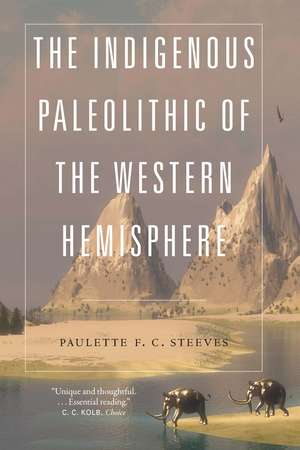The Indigenous Paleolithic of the Western Hemisphere
Autor Paulette F. C. Steevesen Limba Engleză Paperback – mai 2023
The Indigenous Paleolithic of the Western Hemisphere is a reclaimed history of the deep past of Indigenous people in North and South America during the Paleolithic. Paulette F. C. Steeves mines evidence from archaeology sites and Paleolithic environments, landscapes, and mammalian and human migrations to make the case that people have been in the Western Hemisphere not only just prior to Clovis sites (10,200 years ago) but for more than 60,000 years, and likely more than 100,000 years.
Steeves discusses the political history of American anthropology to focus on why pre-Clovis sites have been dismissed by the field for nearly a century. She explores supporting evidence from genetics and linguistic anthropology regarding First Peoples and time frames of early migrations. Additionally, she highlights the work and struggles faced by a small yet vibrant group of American and European archaeologists who have excavated and reported on numerous pre-Clovis archaeology sites.
In this first book on Paleolithic archaeology of the Americas written from an Indigenous perspective, The Indigenous Paleolithic of the Western Hemisphere includes Indigenous oral traditions, archaeological evidence, and a critical and decolonizing discussion of the development of archaeology in the Americas.
| Toate formatele și edițiile | Preț | Express |
|---|---|---|
| Paperback (1) | 201.35 lei 3-5 săpt. | +19.95 lei 7-13 zile |
| Nebraska – mai 2023 | 201.35 lei 3-5 săpt. | +19.95 lei 7-13 zile |
| Hardback (1) | 503.80 lei 6-8 săpt. | |
| Nebraska – 30 iun 2021 | 503.80 lei 6-8 săpt. |
Preț: 201.35 lei
Nou
Puncte Express: 302
Preț estimativ în valută:
38.55€ • 39.77$ • 31.95£
38.55€ • 39.77$ • 31.95£
Carte disponibilă
Livrare economică 30 ianuarie-13 februarie
Livrare express 16-22 ianuarie pentru 29.94 lei
Preluare comenzi: 021 569.72.76
Specificații
ISBN-13: 9781496234704
ISBN-10: 1496234707
Pagini: 328
Ilustrații: 2 photographs, 8 illustrations, 5 maps, 7 tables, 1 appendix, index
Dimensiuni: 152 x 229 x 24 mm
Greutate: 0.45 kg
Editura: Nebraska
Colecția University of Nebraska Press
Locul publicării:United States
ISBN-10: 1496234707
Pagini: 328
Ilustrații: 2 photographs, 8 illustrations, 5 maps, 7 tables, 1 appendix, index
Dimensiuni: 152 x 229 x 24 mm
Greutate: 0.45 kg
Editura: Nebraska
Colecția University of Nebraska Press
Locul publicării:United States
Notă biografică
Paulette F. C. Steeves (Cree-Métis) is an associate professor of sociology and Canada Research Chair Tier II Indigenous History Healing and Reconciliation at Algoma University. She is also an adjunct faculty at Mount Allison University.
Cuprins
List of Illustrations
List of Tables
Acknowledgments
Introduction
Terminology
1. Decolonizing Indigenous Histories
5. Pleistocene Sites in North America
7. Genetics, Linguistics, Oral Traditions, and Other Supporting Lines of Evidence
Appendix: Pleistocene Sites and References
Notes
Bibliography
Index
List of Tables
Acknowledgments
Introduction
Terminology
1. Decolonizing Indigenous Histories
Finding Home
2. Unpacking Colonial Baggage Rise Up
3. Relations Who Opened the Way Riddle Me This
4. Minds Wide Open 5. Pleistocene Sites in North America
Old World: -60,000
6. Pleistocene Sites in South America 7. Genetics, Linguistics, Oral Traditions, and Other Supporting Lines of Evidence
Memories
8. Reawakening, Resisting, Rewriting All My Relations
Appendix: Pleistocene Sites and References
Notes
Bibliography
Index
Recenzii
"The Indigenous Paleolithic of the Western Hemisphere offers a refreshing perspective of the peopling of what was once called the New World."—Justin A. Holcomb and Curtis N. Runnels, Journal of Island and Coastal Archaeology
"I want people to read this exciting book and challenge our own assumptions about what we know about Indigenous people's past. Reading books such as this one is important if archaeologists are to confront their own troubling history and challenge themselves to tell different stories which celebrate Indigenous people, their land, and their own ideas about where they come from."—Matthew E. Hill, Journal of the Iowa Archeological Society
"Unique and thoughtful. . . . This solid narrative of research findings—the first from a Native American perspective—is essential reading."—C. C. Kolb, Choice
“Writing in the vein of scholars such as Vine Deloria Jr., Paulette Steeves’s critique of the ‘Clovis-first’ model of peopling of the Americas both engages with and moves beyond current ideas about how and when people first came to these lands. The research presented in this book questions the ways archaeologists have traditionally constructed narratives of movement and arrival without considering Indigenous ways of knowing. This is an important and timely contribution to the field.”—Kisha Supernant (Métis), associate professor of anthropology at the University of Alberta
“Paulette Steeves decenters Western power and authority over Indigenous thought, voice, inclusion, and history. The result is an act of healing that benefits both Indigenous people and academic scholarship.”—Randall H. McGuire, Distinguished Professor of Anthropology at SUNY Binghamton University
“A timely analysis of the ethnocentric influences on past and present scientific inquiry and archaeological practice from the perspective of an Indigenous archaeologist. Steeves brings together a host of voices espousing the importance of contextual relationships in hypothesis development and archaeological analysis.”—Kathleen Holen, director of the Center for American Paleolithic Research
“Written from an essential Indigenous perspective, this insightful book examines the existence of First Peoples in the Western Hemisphere for at least 50,000+ years longer than previously accepted and uncovers the reasons this theory has been dismissed for decades.”—Karla Strand, Ms. Magazine
"Paulette Steeves writes this book from a very personal and intimate understanding of the various impacts of Indigenous colonization."—Guadalupe Sánchez, American Anthropologist
Descriere
Paulette F. C. Steeves presents evidence that archaeology sites, Paleo environments, landscapes, and mammalian and human migrations between the Eastern and Western Hemispheres predate Clovis culture (11,200 years ago).
